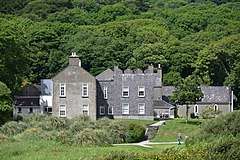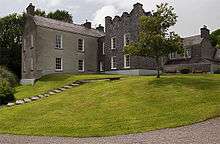Derrynane House
Derrynane House (Irish: "Teach Dhoire Fhionáin") was the home of Irish politician and statesman, Daniel O'Connell.[1] It is now an Irish National Monument and part of a 320-acre (1.3 km²) National Park.
| Derrynane House | |
|---|---|
Teach Dhoire Fhionáin | |
 | |
 Location in Ireland | |
| General information | |
| Status | Museum |
| Type | House |
| Location | County Kerry |
| Country | |
| Coordinates | 51°45′49″N 10°07′44″W |
| Construction started | 1825 |
| Completed | 1844 |
| Renovated | 1967 |
| Website | |
| Heritage Ireland | |
Derrynane House is the ancestral home of Daniel O'Connell, lawyer, politician and statesman. Situated on 120 hectares of parklands on the scenic Kerry coast, the House displays many relics of O'Connell's life and career. Access for visitors with disabilities to ground floor.[2]
The house is located on the Iveragh peninsula on the Ring of Kerry near the village of Derrynane in County Kerry, Ireland (3.5 km from Caherdaniel (off N70 - "Ring of Kerry"[2]). Guided tours of the house are available on request, along with a visual presentation.
History
It was O'Connell's grandparents, Domhnall Mór Ó Conaill and Máire Ní Dhonnchadha Dhuibh, who built or extended the house in the 1700s.[3] The oldest part of the house, built in 1702, was demolished in 1967 for safety reasons during the restoration work. Daniel O'Connell built the two-storey south wing facing the sea and the library wing to the east in 1825, the oldest surviving part of the house. The chapel was added in 1844 and was modelled on the ruined monastery chapel of Ahamore Abbey on nearby Abbey Island. Restoration work was completed in 1967, when the house was officially opened to the public as a museum by President De Valera.[4]
See also
- O'Connell of Derrynane
- Derrynane Abbey
References
- "Derrynane House". Heritage Ireland. Archived from the original on 15 February 2015. Retrieved 31 January 2015.
- "Derrynane House". Derrynane House. Archived from the original on 2009-03-12. Retrieved 2009-01-23.
- NÍ Úrdail, Meidhbhín (2009). "Ní Dhonnchadha Dhuibh, Máire". In McGuire, James; Quinn, James (eds.). Dictionary of Irish Biography. Cambridge: Cambridge University Press.
- "Archaeological Survey Database SMR No KE106-074". National Monuments Service. Retrieved 31 January 2015.
External links
Gallery
- 19th century
 2005
2005_-_geograph.org.uk_-_1391915.jpg) 2009
2009 2009
2009 2018
2018